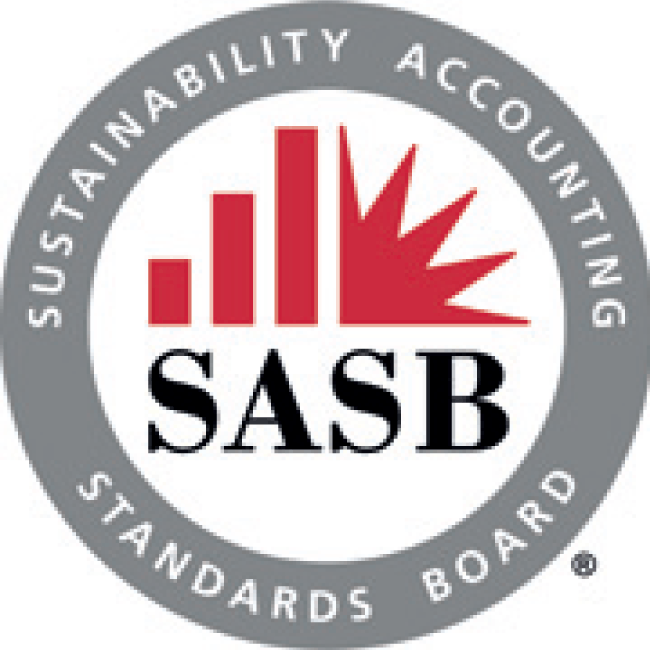Sustainability Accounting Standards Board (SASB)(1)

Created in 2011, SASB (Sustainability Accounting Standards Board, SASB) is an independent, non-profit standard-setting body that develops and maintains reporting standards enabling companies around the world to identify, manage and communicate material non-financial and financial information to investors. The SASB standards are evidence-based, developed with broad market participation and are designed to be beneficial to companies and useful to investors. SASB has established standards specific to 77 industry sectors identified in its Sustainable Industry Classification System® (SICS®). EDF is the first European energy company to act as an advisor within the SASB organisation (2). As such, EDF is proactively involved in the process of revising this standard to enable its use worldwide.
In 2020, EDF was one of the main contributors to the SASB “Globalization Project” (3), which remains to this day, for certain subjects, specific to the American market, particularly in terms of the environment or regulation.
For items for which the standard is identical (e.g. GHG protocol) or close to the standards used in France and Europe, EDF’s Statement of Non-Financial Performance Statement in 2020 covers most of the reporting topics required by SASB for the “Electric Utilities & Power generators” sector:
- Greenhouse Gas Emission & Energy Resources Planning : sections 3.1.1.2.2, 3.1.1.3.1, 3.1.1.3.2, 3.1.1.3.3, 3.1.1.3.4 ;
- Air Quality : section 3.3.1.5 ;
- Water Management : section 3.2.3 ;
- Coal Ash Management : section 3.2.4.3.2 ;
- Energy Affordability : section 3.1.4.3.2 ;
- End use efficiency and Demand : section 3.4.4.2 ;
- Nuclear Safety and Emergency management : section 3.3.1.1 ;
- Grid Resiliency : section 3.1.4.3.1.
3.9.3 Further details relating to compliance with TCFD requirements
This section presents the URD concordance table with TCFD recommendation, as detailed in the report entitled “Implementing the Recommendations of the Task Force on Climate related Financial Disclosures”, TCFD, June 2017.
Concordance table with TCFD recommendations | Relevant sections of the URD |
|---|---|
Governance a) Role of the Board of Directors in the oversight of climate-related issues in the organisation b) Role of the Management in the oversight of climate-related issues in the organisation | Governance a) Role of the Board of Directors in the oversight of climate-related issues in the organisation b) Role of the Management in the oversight of climate-related issues in the organisation Relevant sections of the URD Sections 3.1.3.1 Sections 3.1.3.1 |
Strategy a) Climate-related risks and opportunities over the short, medium, and long term b) Impact of climate-related risks and opportunities on the organisation’s businesses, strategy, and financial planning c) Evaluation of the resilience of the organisation’s strategy, taking into consideration different climate-related scenarios, including a 2°C or lower scenario | Strategy a) Climate-related risks and opportunities over the short, medium, and long term b) Impact of climate-related risks and opportunities on the organisation’s businesses, strategy, and financial planning c) Evaluation of the resilience of the organisation’s strategy, taking into consideration different climate-related scenarios, including a 2°C or lower scenario Relevant sections of the URD Section 3.1.3.2.2 and Appendix 3.9.5 Section 2.2.3 Section 3.1 Section 3.1.3.2 |
Risk management a) Processes for identifying and assessing climate-related risks b) Processes for managing climate-related risks c) Integration into the organisation’s overall risk management processes | Risk management a) Processes for identifying and assessing climate-related risks b) Processes for managing climate-related risks c) Integration into the organisation’s overall risk management processes Relevant sections of the URD Section 3.1.3.2 Sections 2.1 and 2.2.3 Sections 3.1.2 and 3.1.3.2 Sections 2.1 and 2.2.3 Section 2.1 |
Indicators and goals a) Financial and non-financial metrics used by the organisation for its climate-related strategy b) Reporting of Scope 1, Scope 2, and, if appropriate, Scope 3 greenhouse gas emissions c) Climate-related targets used by the organisation and performance against targets | Indicators and goals a) Financial and non-financial metrics used by the organisation for its climate-related strategy b) Reporting of Scope 1, Scope 2, and, if appropriate, Scope 3 greenhouse gas emissions c) Climate-related targets used by the organisation and performance against targets Relevant sections of the URD Section 3.1.1 Section 3.7.2 Section 3.1.1.2 Section 3.1.1.1 d |
